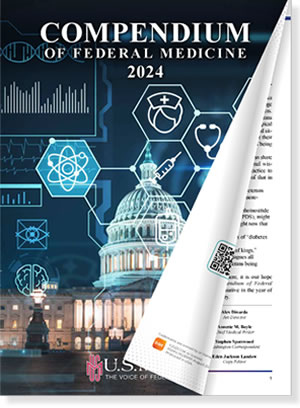BETHESDA, MD—Pharmacies throughout the Military Health System have taken steps to protect their customers and staff from exposure to COVID-19 in recent weeks. Many have adopted curbside pickup and expanded drive-thru capacity. Others have adapted their physical layout, staffing ratios and patient policies to minimize interactions and maintain social distancing.
“The COVID crisis afforded our talented team an opportunity to deliver innovative solutions to the provision of pharmaceutical care under extremely challenging conditions,” said Col. Kevin Roberts, PharmD, pharmacy consultant to the Army Surgeon General.
Many of the adjustments naturally focused on reducing the risk of transmitting the virus.
“We have implemented several operational changes to assist with social distancing and reduce potential exposure; to include establishing 11 drive-thru pharmacies, utilizing isolated work teams to reduce operational impact of an exposure, training our ambulatory pharmacists to support ICU/ventilated patients and increasing protective measures across all 30 pharmacy locations,” said Col. James Masterson, PharmD, MPH, pharmacy consultant for the U.S. Army Regional Health Command-Atlantic based at Fort Belvoir, VA.
The new systems came online with new staff responsibilities, changed work flows and increased protection both broadly and quickly. At Joint Base San Antonio, TX, for example, the Brooke Army Medical Center pharmacy transformed its process and created a curbside pharmacy in under 48 hours.
The Navy made similar adjustments to continue to meet the needs of patients while protecting staff and patients alike from potential exposure to SARS-CoV-2, the novel coronavirus that causes COVID-19.
“Key strategies include setting up or expanding efficient drive-thru pharmacies with curb-side delivery and implementing no-touch procedures for pharmacy processes,” said Navy Capt. Traci Hindman Robinson, PharmD, MBA, MSc, pharmacy consultant, Defense Health Agency.
At the Naval Hospital Pensacola in Florida, the pharmacy assigned four staff members to each lane of its drive-thru. Two took patient information at car windows and radioed the details to two staff members who filled prescriptions. The system enabled the pharmacy to continue to dispense up to 1,200 prescriptions each day.
Joint Base Andrews implemented a variation of the old “car-hop” service: Patients picking up prescriptions turn on their car blinkers to signal pharmacy staff when they pull into the parking garage staging area. Staff members go to the cars to get patient information, retrieve waiting prescriptions from a staging area and deliver the medications to the car.
Some of the recent changes at pharmacies are likely to benefit customers and staff long after the current peak of the novel coronavirus pandemic passes.
“Among other innovations, we continue to implement new techniques, including some that will become permanent assets in delivering pharmacy services such as a new speaker system at some of our satellite pharmacies’ drive-thru that will make pulling prescriptions more efficient,” said Air Force Col. Glenn Laird, PharmD, pharmacy market consultant, DHA.
Other durable changes included installing Plexiglass at pharmacy windows and “leveraging QR codes to manage a virtual queue of cars awaiting curbside pharmacy services,” Laird told U.S. Medicine.
Pharmacies have increased use of technology, too, with some sending text messages to tell patients when prescriptions are ready and Naval Hospital Pensacola releasing an app for refill requests.
Beneficiaries also took steps to reduce their risk by moving prescriptions to home delivery. According to the DHA, 42,000 prescriptions were transferred from MTF pharmacies to home delivery in March, an increase of 63% above the average month. As of mid-April, transfers were trending about 15% above average.
Continue Reading this Article: Few Closures
Few Closures
While most of DHA’s 700 pharmacies have managed to maintain full operations, a few have had to close or reduce services in response to the virus.
In two instances, closures related to supporting hard-hit cities within the U.S. by deploying the USNS Comfort and Mercy to New York and Los Angeles, respectively. Robinson noted that those deployments and establishment of Expeditionary Medical Facilities involved 16 Navy pharmacists and 43 pharmacy technicians.
A few pharmacies briefly shut down as a result of staff illness or quarantine requirements, but all reopened quickly.
“In such instances, we are committed to ensuring that beneficiaries continue to have access to their prescriptions via home delivery and/or retail network pharmacies, with a return to normal operations as soon as it is safely possible to do so,” said Col. Markus Gmehlin, Defense Health Agency Pharmacy Operations Division acting chief.
Seven additional military treatment facility pharmacies have experienced “partial service degradations” as a result of local COVID-19 outbreaks which have restricted activities at military installations, according to the DHA.
Those pharmacies employed creative measures to get necessary medications to patients as conveniently as possible. When retirees faced restricted access at Cannon Air Force Base in New Mexico, for instance, pharmacy staff started holding point of dispensing days in the visitor control center. Staff and volunteers kept the transactions as close to contact-free as possible by putting prescription bags on the hood or roof of retirees’ cars.
“The health and protection of our patients, healthcare teammates, and the community is essential as we preserve the fighting force,” Gmehlin said. “We are taking necessary steps to ensure that our teams who are caring for patients and delivering critical medications do so in a safe environment.”

